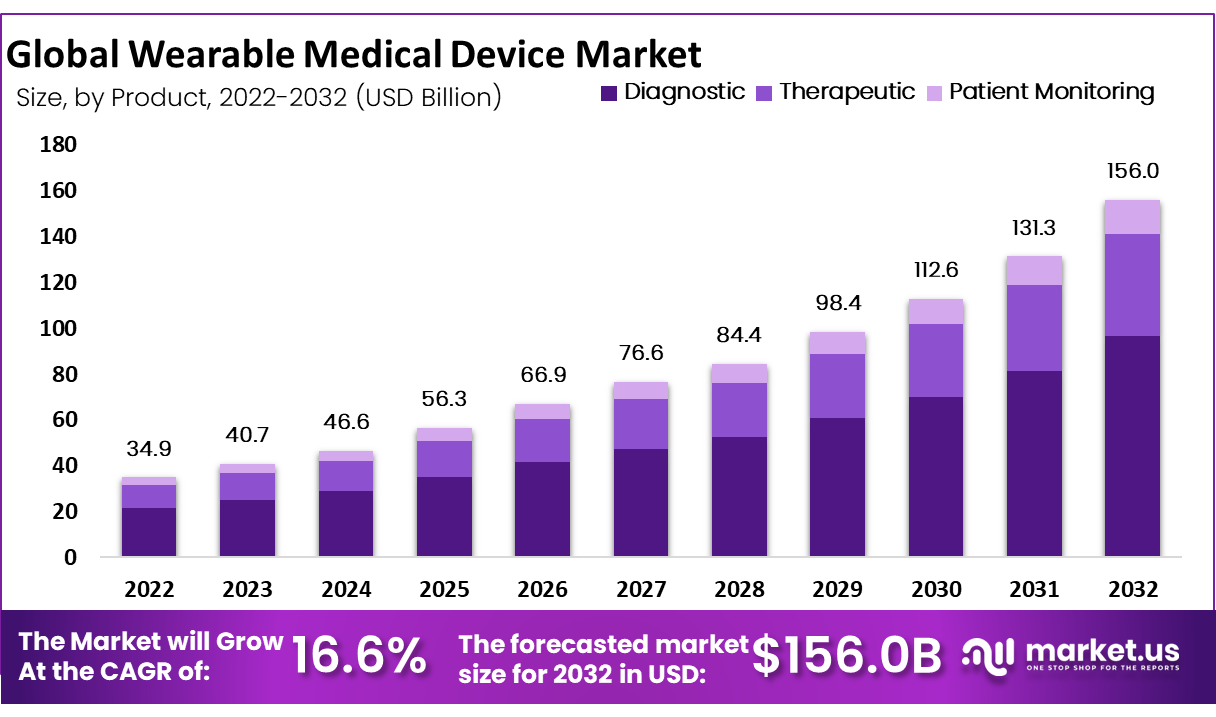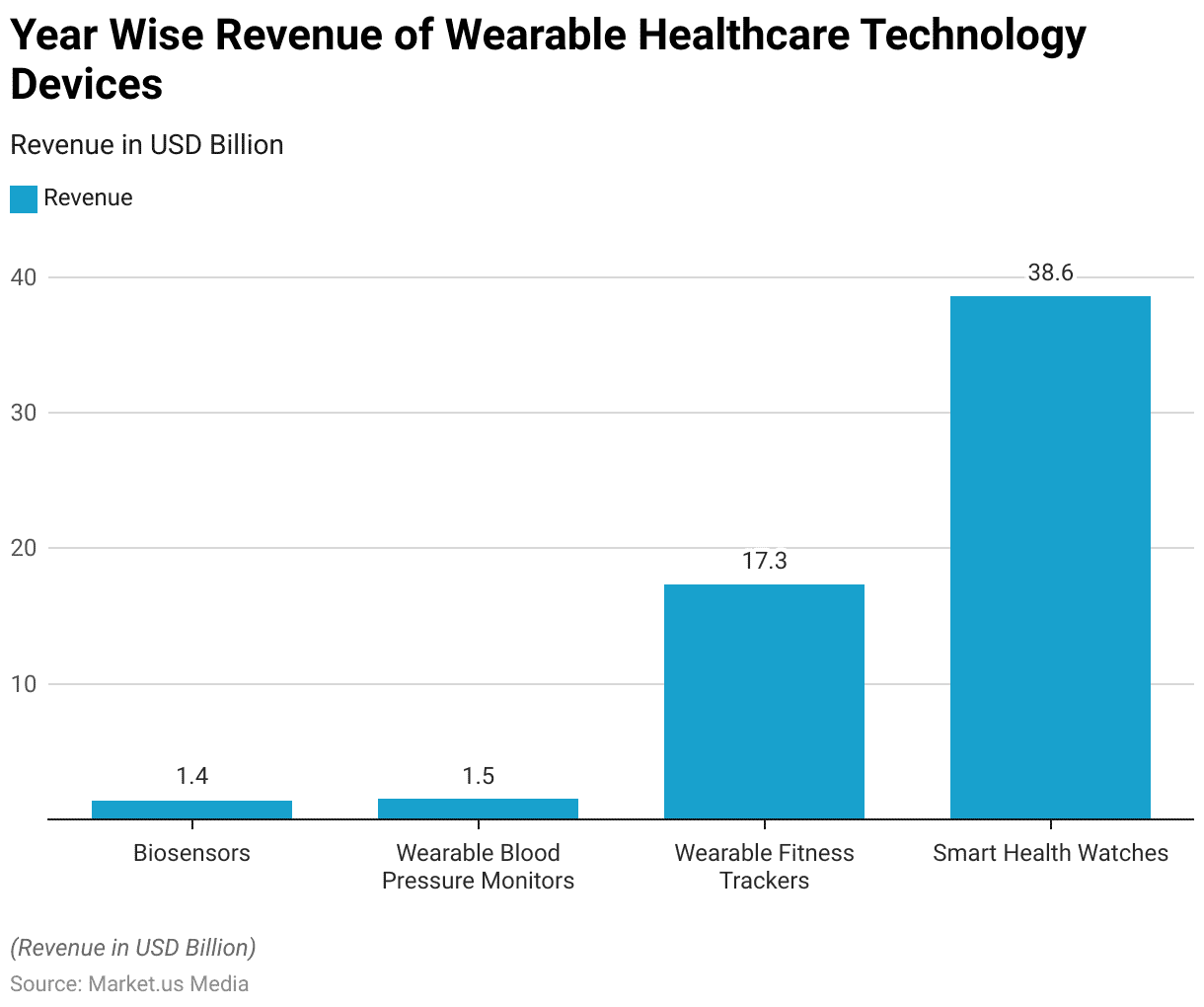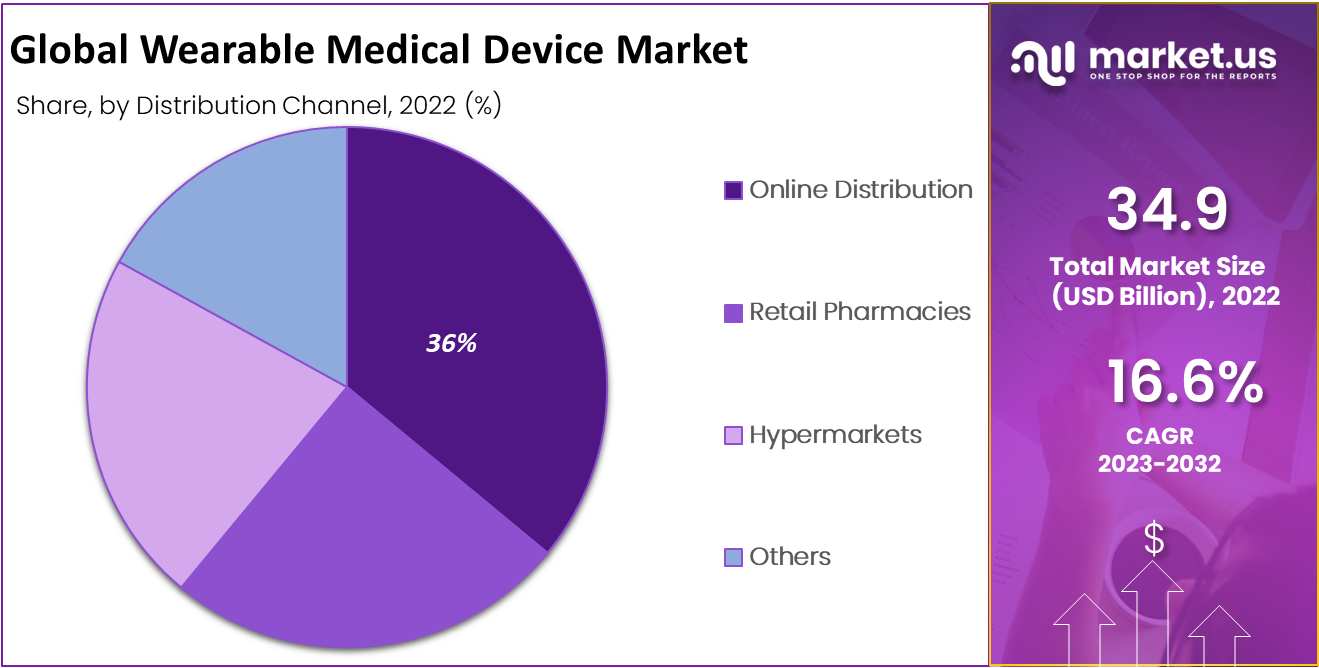Wearable Medical Devices Statistics: Wearable Medical Devices generally refer to devices worn by the user, that can track various health metrics and provide data and insights about the user’s health and well-being.
This includes fitness trackers, smartwatches, medical-grade wearables, and other devices that can monitor vital signs, activity levels, sleep quality, and other health-related data.
Wearable Medical Devices are emerging as an important trend in the healthcare sector, as it has the potential to improve patient outcomes, reduce healthcare costs, and increase access to healthcare services.

Table of Contents
- Editors Choice
- Most Popular Medical Wearable Devices
- Insurance company’s Discounts for Wearable Tech
- Wearable Medical Devices for Research Statistics
- Smartwatches and Smart Patches are Getting Popular
- Wearable Medical Devices Company Revenue Statistics
- COVID-19 Impact on Wearable Medical Devices Statistics
- Wearable Technology and Continuous Monitoring
- Wearable Medical Devices Users in the US Statistics
- Future of Wearable Technology in the Healthcare
- Healthcare Technology Challenges Statistics
- Recent Developments
- Conclusion
- FAQs
Editors Choice
- Wearable Medical Devices Market size is expected to be worth around USD 156.0 Billion by 2032.
- Growing at a CAGR of 16.60% during the forecast period from 2023 to 2032.
(Source: Market.us)

Most Popular Medical Wearable Devices
Wearable Fitness Trackers
- Health monitoring is an emerging trend among consumers worldwide
- Global fitness or activity tracking wrist-wear market revenue was 17.3 billion in 2022.
- Global fitness tracker unit shipment was 101 million in 2022.
(Source: Statista)
Smart Health Watches
- Most users prefer smart health watches to track their heart rate, sleep, oxygen, activity, exercise, calories burnt, etc.
- Smartwatch market revenue was 38.6 billion in 2022
- Smartwatches are the most popular wearable devices globally and it is poised to create revenue of 53.6 billion U.S. dollars by 2025.
(Source: Statista)
Wearable Blood Pressure Monitors
- Hypertension (HTN) is the most common risk factor for cardiovascular disease as it affects about 1 billion people worldwide and its prevalence is estimated to reach 1.5 billion by 2025.
(Source: NIH)
Take advantage of our unbeatable offer - buy now!

Biosensors
- The Biosensors market is expected to reach 1.4 billion USD by 2027 with a compound annual growth rate of 9.4%.
(Source: Statista)

These healthcare devices are designed to gather information and enhance our well-being. The following figures illustrate the emergence of this digital technology’s reach and some of the advantages it offers.
- 30% of Americans living in households with an annual income of at least $75,000 wear either a fitness tracker or a smartwatch. In contrast, only 12% of individuals earning less than $30,000 per year use such devices.
- 25% of women use this healthcare device regularly.
- 26% of Hispanic adults regularly use wearable health technology such as a fitness tracker.
- Approximately 30% (1266 out of 4551) of the adult population utilize wearable healthcare devices.
- Among these users, almost half (47.33%) use these devices daily, and a majority (weighted at 82.38%) are willing to share their health data with their healthcare providers.
- The most likely groups to report using wearable healthcare devices were women 16.25%.
- According to estimates, the market for wearable healthcare devices in 2018 was US $24.57 billion and was slated to grow 24.7% annually to US $139.35 billion by 2026.
(Source: vicert, NCBI)
Insurance company’s Discounts for Wearable Tech
- Certain insurers provide a reduction of 20% for each wearable medical device. The purpose of this discount is to aid their clients in achieving their health objectives by making medical devices more accessible and affordable.
- According to a study, 69% of Americans would be willing to wear a smartwatch if it resulted in a reduction in their insurance premium. Among these individuals, 46% were prepared to share their data.
- 55% were not currently using such technology but would be open to using it in exchange for a discount.
Wearable Medical Devices for Research Statistics
- Wearable Medical Devices play an important role in research and diagnosis. It enables the collection of real-time, comprehensive data that can aid in the identification and treatment of medical conditions.
- Wearables also monitor patients remotely and provide healthcare professionals with valuable insights into their health status.
- Furthermore, these devices can facilitate the creation of personalized treatment plans that are tailored to the specific needs of individual patients.
- Overall, the use of Wearable Medical Devices in research and diagnosis holds significant promise for improving patient outcomes and advancing medical knowledge.
(Source: NCBI)
Smartwatches and Smart Patches are Getting Popular
- According to Deloitte’s 2021 Connectivity and Mobile Trends survey, 39% of participants owned a smartwatch.
- These devices have primarily been used to aid individuals in getting in shape, shedding weight, and achieving their personal best in athletics.
- Most smartwatches now come equipped with heart rate monitors, and some have been approved by the FDA to identify irregularities such as atrial fibrillation, a significant contributor to strokes.
- As smartwatch technology advances, more individuals may use it to manage chronic conditions and detect symptoms of severe illnesses. However, only 12% of those earning less than $30,000 per year currently utilize this technology.
(Source: Deloitte)

Wearable Medical Devices Statistics
- Deloitte’s 2021 Connectivity and Mobile Trends survey found that 39% of respondents owned a smartwatch.
- 88% of physicians want patients to monitor their health parameters at home.
- 30% of American adults use wearable technology for healthcare as of 2020.
- Nearly 50% of users are dependent on wearable technology in daily life, with more than 80% of users willing to share their data with their healthcare providers.
- 92% of smartwatch users use this technology for health-tracking activities.
- Number of connected wearable devices worldwide is rising from 325 million in 2016 to 722 million in 2019.
- Shipments of smartwatches were 100 million in 2020.
- Earwear or ear-worn device shipments were increased by 45% to 105 million units by 2023.
- 86% of patients say that wearable medical devices improve health outcomes.
- wearable technology will flourish over the next 25 years, resulting in global cost savings of over $200 billion in the healthcare industry.
- wearable devices in use in 2020 were approximately 600 million.
- According to the National Library of Medicine, the accuracy and precision of wearable devices typically range from 92% to 99%
- A 2019 study found that 20% of users abandoned their devices, with the most common reasons cited to be related to data literacy, or device comfort
- According to Deloitte Insights, the global market of wearable devices for the medical sector is booming. Compared to 275 million units in 2021, it is projected to reach nearly 440 million units in 2024.
(Source: VICERT, Statista, Software Advice Research, NIH, velvetech)
Smartwatches Statistics
- 59% of people use smartwatches to track their number of steps per day.
- 42% of people use smartwatches to get insights regarding their workout/athletic performance.
- 37% of people use smartwatches to monitor their heart health.
- 35% of people use smartwatches to check their sleep quality and duration of sleep.
- 32% of people get insights regarding calories burned with the help of smartwatches.
- 17% of people use smartwatches to check their stress levels.
(Source: Deloitte)

Wearable Medical Devices Company Revenue Statistics
Fitbit
- Fitbit is the leading company in wearable medical devices with a market share of 40%.
- The company offers Fitbit Sense 2 and Fitbit Versa 4 smartwatches to track daily fitness activities.
- Fitbit made an estimated $1.21 billion in revenue in 2021, a 7% increase from the year prior.
- Over 31 million people use Fitbit once a week.
(Source: Statista, businessofapps)
Apple
- Apple Ins. Holds a market share of 24.1% in the global market.
- As of 2021, its market valuation exceeded $2 trillion, making it the most valuable technology company in the world.
- In the year 2022, Apple Services accounted for 19% of the company’s revenue, making it the second-largest division within Apple.
(Source: Statista, businessofapps)
Garmin
- Garmin holds a lucrative market share of 25.57% in global wearable medical devices.
- Garmin produces a variety of devices, including wearable technology that tracks fitness and health for individuals of all ages.
- They offer an all-day activity tracker that monitors steps, distance, intensity, and calories to assist users in maintaining their health and fitness objectives.
- Additionally, Garmin’s wearable products, such as the Venu series, track bodily patterns, sleep quality, and heart rate, and are compatible with both Apple and Android smartphones for added convenience.
- In 2022, Garmin generated 4.86 billion U.S. dollars in revenue.
(Source: CSI Market, Statista)
Philips Healthcare
- The company had a 3% share of the global MedTech market.
- Philips Healthcare’s Annual Revenue is US$6.8 Billion.
(Source: zippia)
Omron Healthcare
- OMRON blood pressure monitors are available in more than 110 countries/regions across the world, commanding a market share of approximately 46% worldwide.
- www.omronhealthcare.la traffic has increased by 33.47%.
- Omron’s revenue for the quarter ending September 30, 2022, was $M, a 100% decline year-over-year.
(Source: Omron, macrotrends)

Medical wearable devices market revenue worldwide in 2021 and 2026, by region
- It is projected that the medical wearables market will experience substantial growth between 2021 and 2026, with an increase in value from 20.1 billion U.S. dollars to 83.9 billion U.S. dollars.
- The North American market is anticipated to generate more revenue than the European market, with an estimated value of approximately 33.6 billion U.S. dollars by 2026.
(Source: Statista)
COVID-19 Impact on Wearable Medical Devices Statistics
- More than 722 million wearable devices in 2019 were in use globally.
- pandemic has led to an increase in the use of wearables as more individuals have become interested in monitoring their health and tracking their physical activity while staying at home.
- Wearable adoption and use were both up in 2020, jumping up 10% points from 33% in 2019 to 43%. Emerging trends such as women’s health for fertility and menstrual tracking contributed to the proliferation of wearables.
- 63% of women track their fertility and 67% of women track their menstrual cycle by using wearables.
- The consumer groups most likely to track their health digitally were under 55 years old.
(Source: news-medical, rock health)
Consumers Sharing Preference Changed During COVID-19 Pandemic
- 43% of respondents reported that they had a video visit as compared to 32% in 2019.
- Wearable use was up in 2020, with 43% of all respondents reporting that they owned a wearable up from 33% in 2019.
- Chronic condition management could be driving this uptick, with 66% of those who started using wearable for the first time during COVID-19 using them to manage health conditions.
- Overall half of the respondents tracked health metrics (eg., weight, heart rate, and blood pressure) using a digital tracker, up 12% points from 2019.
- 60% of respondents search for provider reviews online, which is a slightly smaller percentage than in 2029.
- The majority of respondents continue to search online for health information such as symptoms, treatment, and medications a slightly smaller percentage of respondents reported doing so 67% in 2020 vs 73% in 2019.
(Source: Rock Health)
Wearable Technology and Continuous Monitoring
- Wearable technology could drop hospital costs by as much as 16% over 5 years, and remote patient monitoring technologies could save our healthcare system $200 billion over the next 25 years.
- 35% of employees use medical wearable technology to facilitate wellness programs and lower health insurance costs.
- More than half of wearable users believe that wearable technology has improved their mental health.
- Additionally, 15% of surveyed patients said their device gave them the ability to receive remote care, indicating a huge area for growth, especially for rural patients.
- According to a survey, 39% of people who identify as Caucasian find it unacceptable to share their data, while 31% of African Americans and 26% of Hispanic adults expressed discomfort with sharing their data.
(Source: emedcert)
Wearable Medical Devices Users in the US Statistics
- About 63% of the US population uses fitness trackers.
- 63% of individuals use smartwatches to track their fitness activities.
- 21% population uses VR headsets.
- 18% of individuals use sleep tracker devices.
- 10% of individuals in the United States use smart clothing.
- Among the all population, 10% of the population uses smart eyewear.
- 6% of individuals use posture correctors.
- 4% of the population uses other wearable devices to track and monitor their healthcare goals.

Future of Wearable Technology in the Healthcare
- With advancements in technology, wearables are becoming more sophisticated and capable of providing real-time data on various health metrics. This data can be used to monitor and manage chronic conditions, identify potential health issues before they become severe, and personalize treatment plans for patients.
- The rising emergence of wearables with electronic health records (EHRs) helps in providing a comprehensive view of patient health and enables healthcare providers to make informed decisions.
- Artificial intelligence (AI) and machine learning (ML) algorithms can be used to analyze wearable data and provide insights that were previously not possible.
- The future of wearable technology in the healthcare industry holds tremendous potential for improving patient care and transforming the way healthcare is delivered.
Healthcare Technology Challenges Statistics
- Data privacy and security are the biggest concerns associated with wearable medical devices.
- According to a survey by Accenture, 75% of patients are concerned about the privacy of their health data, and 64% are concerned about data security.
- Only 34% of wearable devices accurately tracked energy expenditure.
- Roughly half of the users of fitness trackers (53%) say this is acceptable, compared with 38% of those who do not use fitness trackers.
(Source: Accenture, American Medical Association, Pew Research)
Recent Developments
Acquisitions and Mergers:
- FitTech Inc. acquired HealthWear Solutions in a deal valued at $150 million, consolidating its position in the wearable medical devices market and expanding its product offerings.
- MediWear merged with TechHealth Innovations, creating a comprehensive platform for remote patient monitoring solutions, with combined revenues projected to surpass $300 million within the next fiscal year.
New Product Launches:
- VitalTrack unveiled a new wearable device equipped with advanced biosensors for continuous monitoring of vital signs such as heart rate, blood pressure, and oxygen saturation, aiming for a 25% increase in market penetration within the first six months.
- BioSense launched a wearable glucose monitor for diabetic patients, providing real-time data insights and predictive analytics to optimize the management of blood sugar levels, with an expected market adoption rate of 30% in the diabetic population.
Funding Rounds:
- LifeWear Technologies secured $50 million in Series C funding led by Healthcare Investment Group to accelerate product development and expand distribution channels, targeting a 50% increase in sales revenue over the next fiscal year.
- MediSense raised $20 million in a venture capital round led by Biotech Fund to support clinical trials and regulatory approvals for their innovative wearable device designed for continuous monitoring of respiratory conditions, anticipating a 40% growth in market share upon commercial launch.
Consumer Trends:
- Rising awareness of preventive healthcare and the growing aging population contributed to the surge in demand for wearable medical devices, with sales of activity trackers and cardiac monitors experiencing a 25% and 30% growth, respectively.
- Integration of artificial intelligence (AI) and machine learning algorithms in wearable devices gained traction, enabling personalized health insights and proactive health management, leading to a 35% increase in consumer adoption.
Regulatory Landscape:
- Regulatory bodies implemented streamlined approval processes for wearable medical devices, fostering innovation and market entry for new entrants, while ensuring adherence to safety and efficacy standards to protect consumer interests.
Conclusion
Wearable Medical Devices Statistics – Wearable medical devices have become more popular in recent years because they offer benefits such as convenience, remote monitoring, and personalized healthcare.
With increasing advancements in wearable technology, patients can now monitor their chronic conditions and share their data with their healthcare providers in real-time, which helps in providing accurate diagnosis.
Wearable medical devices have not only benefits but also challenges that must be addressed. There is a need to address data privacy and security concerns.
Overall, wearable medical devices have great power to improve healthcare outcomes and patient experience.
However, it is very important to carefully consider the benefits and challenges before implementing wearable healthcare technologies on a large scale.
FAQs
Healthcare wearable technology has great potential for data gathering and cutting-edge health research. They are capable of collecting information for more effective and precise clinical diagnosis.
Fitbit, Apple, Garmin, Omron Healthcare, and Philips Healthcare are the top companies in wearable medical devices among others.
Wearable Fitness Trackers, Smart Health Watches, Wearable Blood Pressure Monitors, and Biosensors are some most popular wearable medical devices.
The pandemic accelerated the adoption of telemedicine, which in turn increased the use of wearables for remote patient monitoring. Wearables that track vital signs, physical activity, and sleep patterns have become increasingly popular among patients and healthcare professionals alike.
Wearable technology could drop hospital costs by as much as 16% over 5 years, and remote patient monitoring technologies could save our healthcare system $200 billion over the next 25 years.
Discuss your needs with our analyst
Please share your requirements with more details so our analyst can check if they can solve your problem(s)



